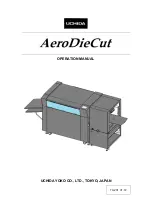
Section 4: Operating Instructions
RCR1548 Rotary Cutters 312-556M
8/1/23
24
Field Operation
DANGER
!
To avoid serious injury or death:
1.
Thoroughly inspect area to be cut for debris and
unforeseen objects. Mark any potential hazards.
2.
Follow
instructions on this
page to start cutter blades turning.
3.
Optimum ground speed depends on density of
material being cut, horsepower rating of tractor, and
terrain. Always operate tractor at cutter’s full rated
power take-off speed in a gear range that allows the
cutter to make a smooth cut without lugging tractor
down, usually between 2 to 5 mph (3 to 8 km/h).
4.
Stop traveling and disengage power take-off after the
first 50 ft (15 m) of cutting. Check cutter levelness and
cutting height to make certain it is adjusted properly.
5.
Do not engage power take-off with 3-Point cutter fully
raised.
6.
Periodically disengage power take-off, shut down
tractor, remove key, and check for foreign objects
wrapped around the blade spindle. Block cutter deck
up before removing objects.
7.
Frequently inspect cutter for loose bolts and nuts.
Tighten all loose bolts and nuts as indicated in the
“Torque Values Chart”
8.
For additional information, see
Maintain correct power take-off speed.
Loss of power take-off speed will allow blades to
swing back resulting in ragged, uneven cutting.
IMPORTANT:
Your cutter is equipped with free
NOTE:
Do not cut in wet conditions. Wet material
will build up on the deck underside creating poor
discharge, high wear, and additional horsepower.
Periodically disengage power take-off, turn off
tractor, remove key & check for objects wrapped
around blade spindle. Block deck up before removing
objects.
Frequently inspect cutter for loose bolts and nuts.
Tighten all loose hardware as indicated in the
“Torque Values Chart”
on page 36.
General Operating Instructions
It is important that you familiarized yourself with the
Operator’s Manual, completed Operators Checklist,
properly attached cutter to your tractor, made leveling
adjustments, and preset your cutting height before
beginning a running operational safety check on your
Land Pride Rotary Cutter.
The running operational safety check may now be done.
It is important that at any time during this safety check
you detect a malfunction in either the cutter or tractor that
you immediately shut the tractor off, remove its’ key, and
make necessary repairs and/or adjustments before
continuing on.
Make sure before starting the tractor that the park brake
is engaged, the power take-off is disengaged, and the
cutter is resting on the ground. Start the tractor and set
the engine throttle speed at a low idle. Raise the cutter
with the tractor’s rear hydraulic lift control lever to
transport position making sure that the power take-off
shaft does not bind and does not contact the cutter frame.
Lower the cutter to the ground and at a low engine speed
engage the power take-off. If everything is running
smoothly at a low idle, slowly raise the cutter to transport
height checking for bind or chatter in the driveline. Lower
the cutter to the ground and increase the tractor’s engine
rpm until it reaches the cutter full power take-off operating
speed of 540 rpm. If everything is still running smoothly,
once more raise the cutter to transport height to check for
driveline bind or chatter. Lower the cutter to the ground,
return the engine to a low idle, and disengage the power
take-off. Position the adjustable stops on the tractor’s
hydraulic lift lever so the cutter can be consistently
returned to the same cutting and transport height.
You should now be ready to transport to your cutting site
at a safe ground speed. On roadways transport in such a
manner that faster moving vehicles can easily see you
and pass you safely. Reduce your speed when travelling
over rough and hilly terrain. Avoid quick or sharp steering
corrections. Take extra care to ensure that the mower
doesn’t come into contact with obstacles such as trees,
buildings or fences. Use accessory lights and
appropriate reflective devices to provide adequate
warning to pedestrians and other vehicle operators when
traveling on public roads and in the dark of night. Comply
with all local, state, and federal laws.
It is important that you inspect the area where you will be
cutting and clear it of safety hazards and foreign objects
either before or after you arrive at the cutting site. Never
assume the area is clear. Cut only in areas you are
familiar with and are free of debris and unseen objects.
Extremely tall grass should be cut twice to detect
potential hazards. In the event you do strike an object
stop the cutter and tractor immediately to inspect and
make necessary repairs to the cutter before resuming
operation. It really pays to inspect a new area and to
develop a safe plan before cutting.















































